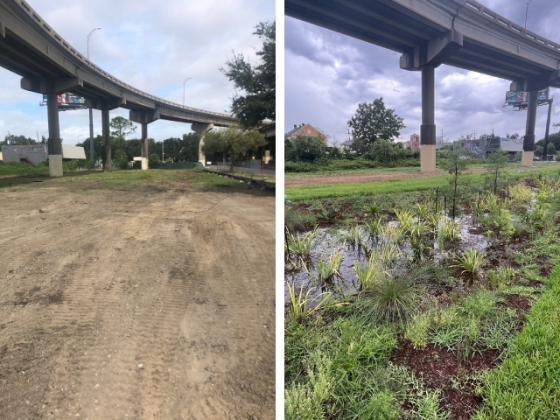Claiborne Avenue
For more than a century, Claiborne Avenue served as a center of New Orleans’ Black economic and cultural life. As the main street in Tremé, one of the oldest African-American neighborhoods in the country, the tree-lined avenue hosted generations of family businesses and community gatherings. Then, in the late 1960s, everything changed.

A federal infrastructure initiative leveled the large oak trees, azalea gardens, and more than 100 homes and businesses to make space for an elevated freeway to cut through the heart of the community. To add to the tragedy, the largely unwanted highway increased exposure in the surrounding communities to pollution, noise, and flooding.
While debates about the freeway’s future have been reinvigorated by the passing of the latest infrastructure bill, Groundwork New Orleans and its network of partners, including Healthy Community Services, aren’t waiting for change to happen – they’re making it happen.
Working together, Groundwork New Orleans, Healthy Community Services, and other community-based partners are putting shovels in the ground to address much-needed climate resilience challenges – including flooding and extreme heat –and creating beautiful outdoor spaces for the community to gather once again. At the top of their priority list is the 7th Ward Project.
7th Ward Priority Project
At the intersection of N. Claiborne Ave and St. Bernard is a small plot of land in the shadow of the freeway. When Healthy Community Services acquired the land, it was an empty, swampy plot abutting a neighborhood with an overwhelmed stormwater system and, consequentially, frequent flooding problems. With Groundwork New Orleans serving as construction manager for the site, plans were drawn to install a bioretention facility to divert stormwater from the surrounding streets and prevent standing water on the green space.

After completing the project’s first phase, the site can now manage about 35,000 gallons of stormwater at a time. That equates to about 800 bathtubs full of water! Not only does this keep stormwater from flooding the surrounding streets, but the project also diverts stormwater from entering the city’s already overwhelmed pumping system.
Additional benefits include:
- purifying the stormwater to improve water quality
- reduction of air pollution and noise once the newly planted trees mature
- neighborhood beautification
- creation of a new gathering space for community members
Changing Places, Changing Lives
Strategic planning for the Greater New Orleans region calls for a significant investment in green infrastructure and the creation of approximately 1,102 new green infrastructure jobs in the region. To prepare young people from the community to take advantage of these job opportunities, Groundwork New Orleans employs young adults enrolled in one of several neighborhoods workforce development programs, including Groundwork New Orleans Ground Crew, LA Green Corps, and NOTEP Trade School to complete large-scale projects like the 7th Ward Priority Project. All trainees completed the Center for Watershed Protection’s clean water certificate program and used their skills to complete hands-on green infrastructure installation projects. Through this program and similar green infrastructure installation opportunities across the city, Groundwork New Orleans and its partners seek to provide young people with tangible and marketable skills to gain meaningful employment in the trades following their tenure in the workforce development programs.
“We can’t afford to pass up opportunities to build a pathway for our young people into high-wage employment. Through this project and others like it, each of these training organizations and their trainees receives hands-on real-time training in Green Infrastructure methodology and installation. By coupling the completion of the CWC and NCCER certification programs with hands-on application, we believe our model provides the most effective training, leading to high-wage employment in the sector while meeting tangible green infrastructure needs in communities throughout New Orleans.“ Todd Reynolds, Executive Director, Groundwork New Orleans
What comes next?
Phase one of the work – the installation of green infrastructure – may have wrapped up in January 2022, but there is a bigger vision for this space and the broader transformation of Claiborne Ave. Ultimately, the goal is to address the stormwater challenges and create active parks for gathering and recreation at this site and other sites along the historic avenue.
The next phase of work on this site will activate the space by installing additional stormwater features, pubic seating to create gathering spaces, and additional fencing and signage to increase the sense of place and safety.
While this won’t bring back the tree-lined Avenue in the short term, projects like the 7th Ward Priority Projects go a long way towards repairing the epic environmental, social, and health damage done to this community – one block at a time.
To learn more about Groundwork New Orleans and how they are building the capacity of young people to transform their environment, visit: Groundwork New Orleans
